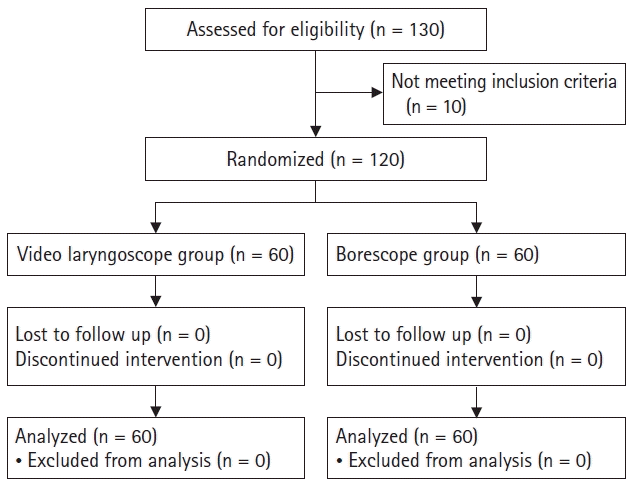1. Samsoon GL, Young JR. Difficult tracheal intubation: a retrospective study. Anaesthesia. 1987; 42:487–90.
2. Mallampati SR. Clinical sign to predict difficult tracheal intubation (hypothesis). Can Anaesth Soc J. 1983; 30:316–7.
3. Gonzalez H, Minville V, Delanoue K, Mazerolles M, Concina D, Fourcade O. The importance of increased neck circumference to intubation difficulties in obese patients. Anesth Analg. 2008; 106:1132–6.
4. el-Ganzouri AR, McCarthy RJ, Tuman KJ, Tanck EN, Ivankovich AD. Preoperative airway assessment: predictive value of a multivariate risk index. Anesth Analg. 1996; 82:1197–204.
5. Shiga T, Wajima Z, Inoue T, Sakamoto A. Predicting difficult intubation in apparently normal patients: a meta-analysis of bedside screening test performance. Anesthesiology. 2005; 103:429–37.
6. Vannucci A, Cavallone LF. Bedside predictors of difficult intubation: a systematic review. Minerva Anestesiol. 2016; 82:69–83.
7. Frerk C, Mitchell VS, McNarry AF, Mendonca C, Bhagrath R, Patel A, et al. Difficult Airway Society 2015 guidelines for management of unanticipated difficult intubation in adults. Br J Anaesth. 2015; 115:827–48.
8. Muallem M, Baraka A. Aids for facilitation of difficult tracheal intubation review and recent advances. Middle East J Anaesthesiol. 2012; 21:785–91.
9. Gill RL, Jeffrey AS, McNarry AF, Liew GH. The availability of advanced airway equipment and experience with videolaryngoscopy in the UK: two UK surveys. Anesthesiol Res Pract. 2015; 2015:152014.
10. Dawson AJ, Marsland C, Baker P, Anderson BJ. Fibreoptic intubation skills among anaesthetists in New Zealand. Anaesth Intensive Care. 2005; 33:777–83.
11. Avidan A, Shapira Y, Cohen A, Weissman C, Levin PD. Difficult airway management practice changes after introduction of the GlideScope videolaryngoscope: A retrospective cohort study. Eur J Anaesthesiol. 2020; 37:443–50.
12. Moon Y, Oh J, Hyun J, Kim Y, Choi J, Namgoong J, et al. Cost-effective smartphone-based articulable endoscope systems for developing countries: instrument validation study. JMIR Mhealth Uhealth. 2020; 8:e17057.
13. Sanri E, Akoglu EU, Karacabey S, Verimli U, Akoglu H, Sehirli U, et al. Diagnostic utilities of tracheal ultrasound and USB-endoscope for the confirmation of endotracheal tube placement: a cadaver study. Am J Emerg Med. 2018; 36:1943–6.
14. Karippacheril JG, Umesh G, Nanda S. Assessment and confirmation of tracheal intubation when capnography fails: a novel use for an USB camera. J Clin Monit Comput. 2013; 27:531–3.
15. Aziz MF, Dillman D, Fu R, Brambrink AM. Comparative effectiveness of the C-MAC video laryngoscope versus direct laryngoscopy in the setting of the predicted difficult airway. Anesthesiology. 2012; 116:629–36.
16. Lewis SR, Butler AR, Parker J, Cook TM, Schofield-Robinson OJ, Smith AF. Videolaryngoscopy versus direct laryngoscopy for adult patients requiring tracheal intubation: a Cochrane Systematic Review. Br J Anaesth. 2017; 119:369–83.
17. Kill C, Risse J, Wallot P, Seidl P, Steinfeldt T, Wulf H. Videolaryngoscopy with glidescope reduces cervical spine movement in patients with unsecured cervical spine. J Emerg Med. 2013; 44:750–6.
18. Adánez Martínez MG, Leal Costa C, García López JA, Torres Ganfornina M, Ramos Morcillo AJ, Hernández Ruipérez T, et al. Perception of level of knowledge, skills, and safety before and after training to perform videolaryngoscopy with the Intubox barrier system for airway management in patients with COVID-19. Emergencias. 2021; 33:93–9.
19. Findik M, Kayipmaz AE, Kavalci C, Sencelikel TS, Muratoglu M, Akcebe A, et al. Why USB-endoscope laryngoscopy is as effective as video laryngoscopy. Clin Invest Med. 2020; 43:E55–9.
20. Saha S. A do-it-yourself video laryngoscope for endotracheal intubation of COVID-19 positive patient. Indian J Anaesth. 2020; 64:904–5.
21. Saoraya J, Musikatavorn K, Sereeyotin J. Low-cost videolaryngoscope in response to COVID-19 pandemic. West J Emerg Med. 2020; 21:817–8.




 PDF
PDF Citation
Citation Print
Print





 XML Download
XML Download